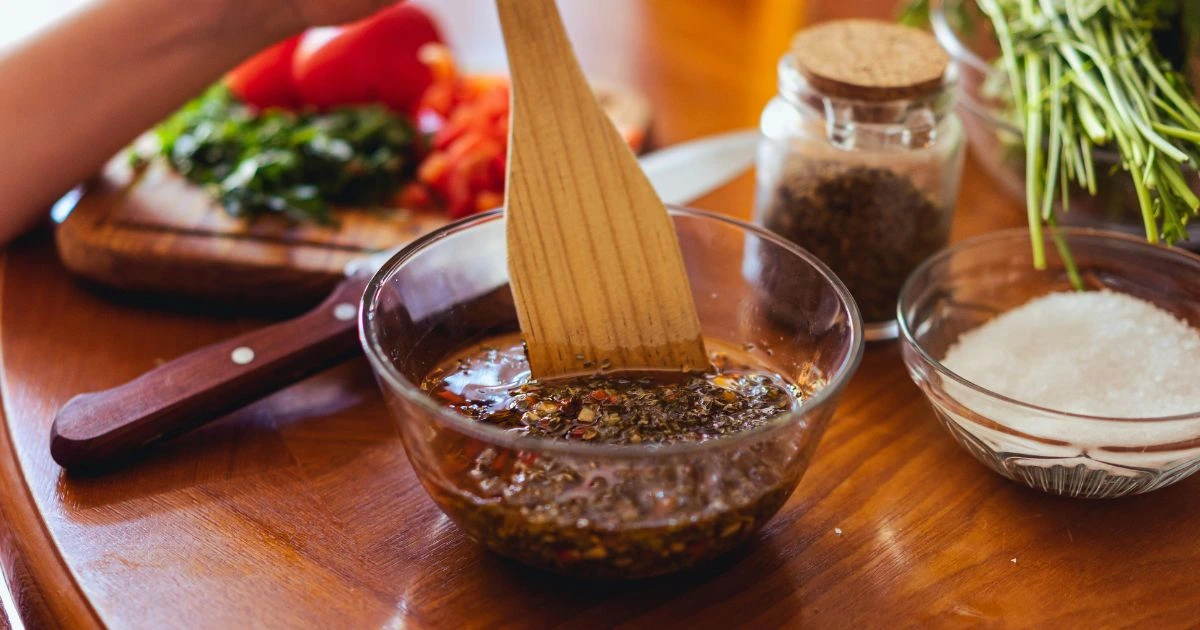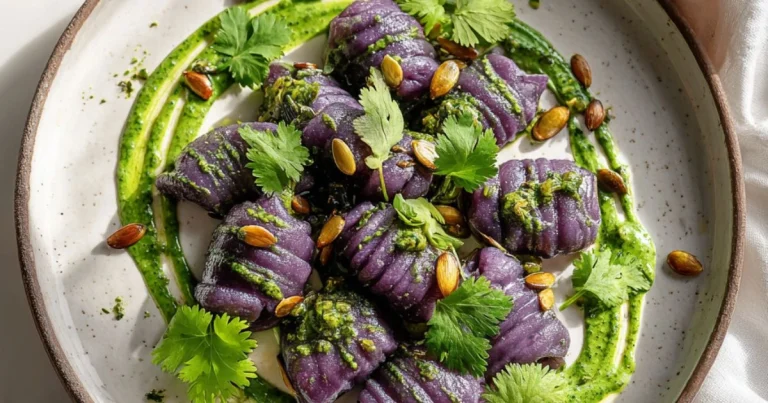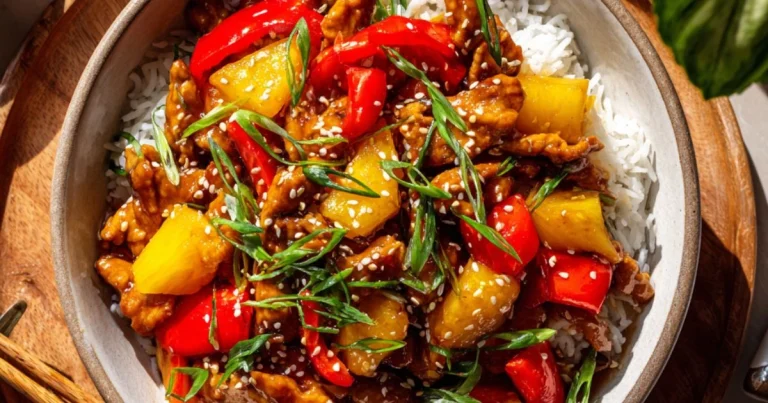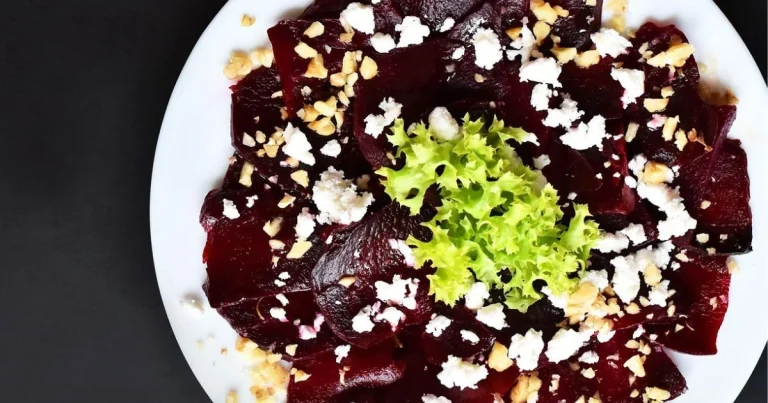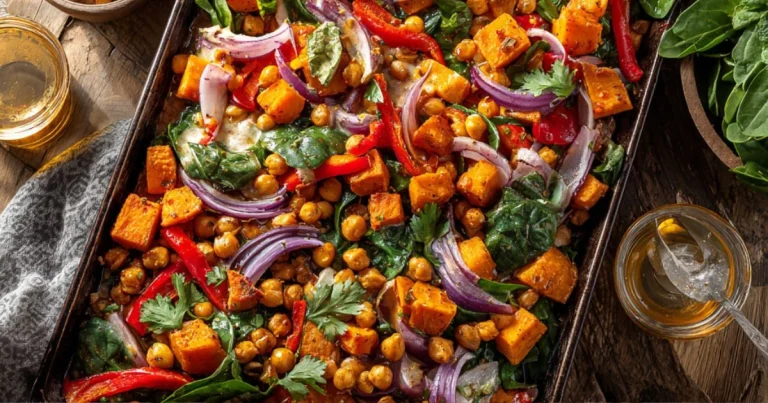Authentic chimichurri sauce
If you’ve ever enjoyed a smoky, grilled steak in Argentina or Uruguay, you’ve likely encountered the bright, punchy flavors of chimichurri sauce. This iconic green sauce isn’t just a condiment—it’s a cultural symbol. Revered in South American cuisine, authentic chimichurri sauce is both rustic and refined, packing layers of flavor with minimal ingredients.
Unlike store-bought blends or over-processed variations, the true chimichurri is raw, fresh, and made by hand—no blending, no shortcuts.
The Origins of Chimichurri Sauce
Chimichurri has deep roots in Argentine and Uruguayan food culture. It emerged from the traditional asado (barbecue) lifestyle, where grilled meats were paired with this vibrant herb sauce to balance out the richness.
The sauce’s name is shrouded in legend. Some believe it stems from an Irish soldier named Jimmy McCurry who fought alongside Argentinians and developed a version of this sauce, while others attribute it to a bastardized Basque phrase. Regardless of the origin, one thing is certain: chimichurri is now a staple of the grill.
To explore the cultural origins of chimichurri, check out this historical deep dive from The Spruce Eats.
What Goes Into Authentic Chimichurri?
While there are many spinoffs, the authentic chimichurri recipe stays true to its core elements. It’s simple, raw, and meant to complement—not overpower—the food it’s served with. Unlike pesto, which is often creamy, chimichurri is vinegary and herbaceous.
According to MasterClass on what is chimichurri, these are the key components:
The beauty of authentic chimichurri sauce lies in its simplicity and the balance of bold, raw flavors. This no-cook condiment uses just a handful of ingredients—each playing a critical role in achieving the traditional Argentine taste.
1. Flat-Leaf Parsley
The foundation of any traditional chimichurri, flat-leaf parsley brings a grassy, slightly bitter note and vibrant green color. Avoid curly parsley—it lacks the intensity and texture needed.
2. Fresh Garlic
Minced garlic is essential for the pungent, savory backbone of the sauce. Use fresh cloves and mince them finely by hand; the rawness is what gives chimichurri its bite.
3. Red Wine Vinegar
A splash of red wine vinegar adds acidity and brightness, balancing the oil and herbs. Authentic versions never use balsamic or white vinegar, which alter the flavor profile.
4. Extra Virgin Olive Oil
High-quality extra virgin olive oil acts as the carrier of flavor, bringing richness and a smooth texture. It melds with the herbs and vinegar to create a balanced emulsion.
5. Dried Oregano
A pinch of dried oregano introduces earthy depth. While fresh oregano can be too overpowering, the dried version offers subtler complexity.
6. Red Pepper Flakes
These add a gentle heat that lingers without overwhelming the palate. The level can be adjusted to taste, but it’s traditionally mild.
7. Salt and Black Pepper
Fine sea salt and freshly ground pepper round out the mix, amplifying the other flavors.
Each ingredient in authentic chimichurri sauce serves a clear purpose—omit or substitute, and you change the soul of the sauce.
How to Make Chimichurri (Step-by-Step)
Crafting authentic chimichurri sauce is a simple yet intentional process. Every step honors the traditional Argentine method—fresh ingredients, hand preparation, and no cooking. Here’s how to make it the right way:
Step 1: Gather Fresh Ingredients
Make sure you have the essentials on hand:
- 1 cup flat-leaf parsley, finely chopped
- 4 cloves fresh garlic, minced
- 2 tablespoons red wine vinegar
- ½ cup extra virgin olive oil
- 1 teaspoon dried oregano
- ½ teaspoon red pepper flakes
- Salt and freshly ground black pepper, to taste
Use high-quality olive oil and fresh herbs for the most vibrant flavor.
2: Chop by Hand — No Blender
Chop the parsley and garlic very finely with a sharp knife. Avoid food processors—they create a paste, which breaks the authenticity and ruins the rustic texture.
The goal is a chunky, loose mixture where every ingredient is distinct yet well integrated.
3: Mix the Dry Ingredients
In a medium-sized bowl:
- Combine parsley, garlic, dried oregano, and red pepper flakes.
- Add salt and black pepper to taste.
This dry mix allows you to evenly distribute flavors before adding the liquids.
4: Add Vinegar and Oil
Stir in:
- Red wine vinegar
- Extra virgin olive oil
Mix gently but thoroughly until everything is evenly coated and begins to emulsify slightly.
5: Let It Rest
Allow the sauce to sit for at least 30 minutes at room temperature. This gives the flavors time to meld. Ideally, let it rest for a few hours or overnight in the refrigerator.
6: Store Properly
- Store in a sealed glass jar or airtight container.
- Refrigerate for up to 1 week.
- Bring to room temperature before serving, as olive oil solidifies when chilled.
Common Mistakes to Avoid
- Over-blending (results in a puree, not sauce)
- Using white vinegar (too harsh)
- Skipping resting time (flavors won’t bloom properly)
Follow this method, and your chimichurri will be bold, balanced, and beautifully traditional.
How to Use Chimichurri Sauce
Authentic chimichurri sauce is far more than just a steak condiment—it’s a versatile flavor booster that adds herbaceous brightness to a wide variety of dishes. Its balance of acidity, heat, and freshness makes it a go-to companion in the kitchen.
1. Traditional Pairing: Grilled Meats
In Argentina and Uruguay, chimichurri is most famously paired with asado, or grilled meat. It’s spooned generously over:
- Grilled flank steak or skirt steak
- Choripán (Argentine sausage sandwich)
- Grilled lamb chops or pork tenderloin
The acidity from the red wine vinegar and the sharpness of raw garlic cut through the richness of red meat, making it the perfect finishing sauce.
2. Marinade for Proteins
Chimichurri works beautifully as a marinade for:
- Chicken thighs or breasts
- Shrimp, fish, or tofu
- Lamb kebabs or pork chops
Let your protein marinate for 30 minutes to a few hours. The herbs and vinegar tenderize while infusing flavor.
3. Condiment for Vegetables and Grains
Vegetarians and plant-based eaters can enjoy chimichurri on:
- Grilled vegetables like zucchini, bell peppers, and eggplant
- Roasted potatoes or sweet potatoes
- Grain bowls with quinoa or rice
Drizzle it over roasted or grilled vegetables for a zesty finish.
4. Sandwiches, Eggs, and More
Think beyond dinner:
- Use it as a spread in sandwiches or wraps
- Drizzle over scrambled eggs or omelets
- Add a spoonful to soups or stews for herbal brightness
Serving Tips
- Always serve chimichurri at room temperature
- Stir before serving, as oil may separate
- Use as a table condiment, just like salsa or hot sauce
From grilling to meal prep, chimichurri sauce enhances every bite with bold, vibrant flavor.
It pairs perfectly with traditional South American dishes like an Argentinian beet salad with feta for a balanced and colorful plate.
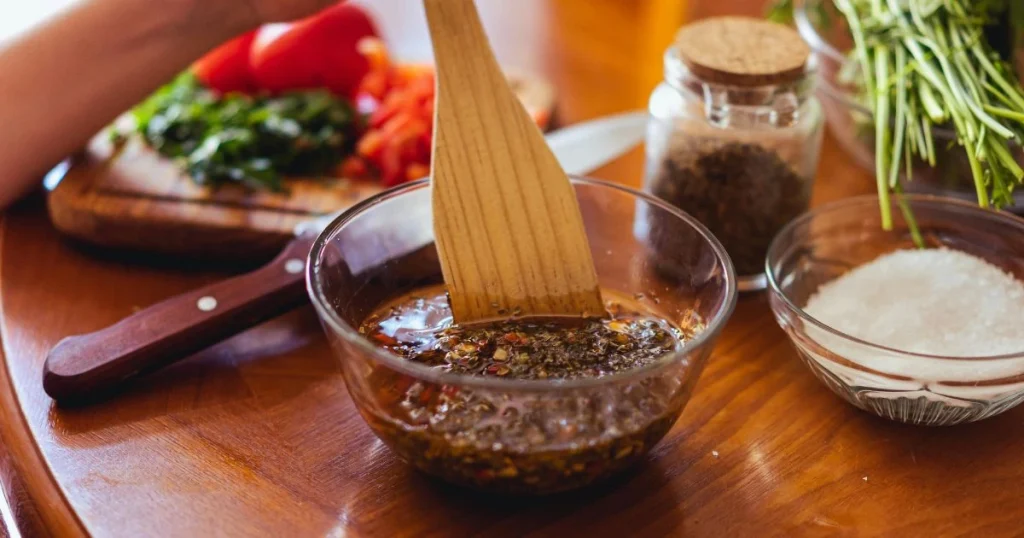
Variations of Chimichurri
While the authentic chimichurri sauce from Argentina is known for its green, herbaceous profile, several regional and modern interpretations have emerged across Latin America and beyond. These variations adapt the core ingredients while introducing new flavors to suit local palates.
Chimichurri Rojo (Red Chimichurri)
Popular in some parts of Argentina and Uruguay, chimichurri rojo includes paprika, tomato paste, or red bell pepper. It has a deeper color and a slightly sweeter, smokier flavor while still retaining its herb and vinegar base.
Spicy Chimichurri
For those who enjoy more heat, extra red pepper flakes, fresh chili, or even jalapeños are added to the traditional green mix. This variation is great as a marinade for bold meats like lamb or spicy grilled chicken.
Cilantro-Based Chimichurri
Some modern recipes substitute or add cilantro to the traditional parsley base. This version is more common in fusion cuisine and pairs well with seafood or tacos.
Chimichurri with Lemon or Lime
To brighten the flavor, some cooks add lemon juice or lime juice for a citrusy twist—especially in modern or California-style variations.
While these versions deviate from tradition, they reflect how chimichurri continues to evolve globally without losing its core identity.
Tips for the Best Chimichurri Every Time
Whether you’re making it for the first time or the hundredth, follow these pro tips:
- Always use flat-leaf parsley—it’s bolder and less bitter
- Use red wine vinegar for authentic tang
- Let the sauce rest overnight if possible
- Avoid blending—you want texture
- Adjust salt and vinegar levels to taste
Common Mistakes to Avoid
- Over-processing: Turns your sauce into a green sludge.
- Using dried herbs: Loses freshness and flavor.
- Too much vinegar: Makes it bitter.
- Not letting it rest: It needs time to “marry” flavors.
Authentic chimichurri should taste fresh, zesty, herbaceous, and balanced.
Frequently Asked Questions
What is chimichurri sauce made of?
Chimichurri is made from parsley, garlic, olive oil, vinegar, oregano, and chili flakes. It’s a raw, herb-based condiment.
Is chimichurri the same as pesto?
No. Pesto uses basil, pine nuts, and cheese. Chimichurri is tangier and doesn’t include nuts or dairy.
How long does chimichurri last?
Stored in an airtight container in the fridge, it lasts up to 1 week. The flavor improves after 24 hours.
Can chimichurri be used as a marinade?
Yes. The vinegar and herbs make it a perfect marinade for meats, tofu, or vegetables.
Is chimichurri spicy?
It can be. Traditional recipes include mild red pepper flakes, but you can make it spicier with fresh chili.
LSI & NLP Keywords Used in This Article
This article has been optimized for the following latent semantic indexing (LSI) and natural language processing (NLP) keywords:
- Argentine sauce
- green herb sauce
- parsley garlic sauce
- chimichurri for steak
- South American condiment
- herb oil dressing
- traditional chimichurri
- easy chimichurri recipe
- chimichurri marinade
- asado sauce
- authentic vs modern chimichurri
Final Thoughts
Authentic chimichurri sauce is a culinary treasure. Its magic lies in the balance between fresh herbs, acidic vinegar, and pungent garlic, making it a perfect match for grilled meats and much more. If you’re serious about flavor, skip the jarred stuff and make it from scratch—it takes just 10 minutes and the results are unforgettable.
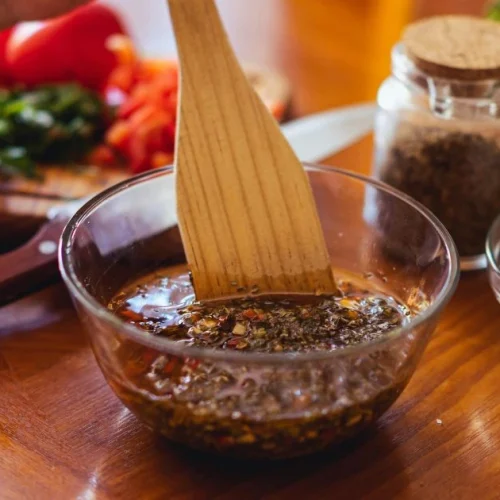
Authentic chimichurri sauce
Ingredients
- 1 cup flat-leaf parsley, finely chopped
- 4 cloves garlic, minced
- 2 tablespoons red wine vinegar
- ½ cup extra virgin olive oil
- 1 teaspoon dried oregano
- ½ teaspoon red pepper flakes
- Salt and freshly ground black pepper, to taste
Instructions
- Finely chop parsley and garlic.
- In a bowl, mix parsley, garlic, oregano, and red pepper flakes.
- Stir in vinegar and olive oil.
- Season with salt and pepper.
- Let sit at room temperature for 30 minutes to allow flavors to meld.
- Store in the refrigerator for up to 1 week.
Notes
Notes:
- Do not use a food processor if aiming for authentic texture.
- Can be adjusted for spice with more chili flakes or fresh chili.
- Flavors intensify after resting overnight.

